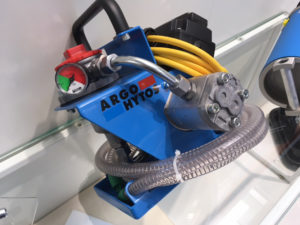Among the announcements coming out of Hannover this week, Argo-Hytos introduced the new CFP compact filter pack. It’s a multi-purpose off-line filtration unit dedicated for servicing compact power packs on a daily basis, not just during start-up or breakdowns. It’s designed for tanks ranging from 1 to 100 l in size.

According to the company, the CFP fills a gap in the market as the first unit designed not only for filling but also for cleaning small hydraulic systems. The special mounting set allows both the suction and pressure hoses to be connected via the ventilating filter port on the tank; the CFP can also be used for off-line filtration.
The unit weighs only 9 kg. It has a flow rate up to 4 lpm, operating pressure of 3.5 bar, and it uses Exapor Max 2 elements rated for 3, 5 or 10 micron filtration. The CFP also has a small electric motor with a 2.5-m cable, 2-m long suction and pressure hoses, and a clogging indicator.
Liebherr presented the new LiView cylinder-position transducer here in Hannover. The rugged system determines the exact piston position and speed through high-resolution absolute measurement and, according to the company, is especially suited for automating mobile machinery.
Measurement systems in off-road equipment are usually subjected to abuse like high vibrations or extreme temperatures, company officials explained. And unlike conventional sensors, LiView uses the piston itself as a robust sensing element. The system consists of processing electronics and two probes. The unit measures the cylinder’s scattering parameters using signals at different frequencies induced onto the cylinder rod itself. Piston position and speed are calculated in real-time.

This design ensures the sensing components are stationary. No moving parts, such as magnets, are required. The electronics can be installed either on the cylinder or directly on the machine. Only the two probe heads require a connection to the piston-rod bearing. The heads ride on an oil film and are therefore wear-free. No further modifications of the cylinder or drilling the piston rod are necessary.
The design ensures easy accessibility of all components. In case of an external damage, this allows fast and simple maintenance – without draining oil, dismantling or even disassembling the cylinder. Space in the cylinder can be used entirely for the idle stroke, as the probe heads are integrated in the piston-rod bearing. Therefore, the full cylinder length is available with the position transducer installed.
LiView is suited for small as well as in very long cylinders in most piston diameters. It calculates piston speed in real time with a measurement cycle of 200 mm for industrial applications and >380 mm for special applications. The technical properties of continuously vulcanized O-rings are comparable with those of O-rings produced by conventional compression molding.

The Engineered Materials Group of Parker Hannifin presented its extensive range of large-size seals at Hannover. Parker Prädifa now offers machined seals made of high-performance polymer materials in diameters up to 4.5 m, metallic C-Rings in diameters up to 7.6 m and precision elastomer O-rings in practically any desired diameter.
The designs combine special material compounds, engineering design techniques, and molding or machining processes in the XXL seals. Materials include polymers such as NBR, EPDM, FKM, PTFE and PEEK, as well as metal.
For example, precision O-rings are manufactured by vulcanization in a closed mold using compression or injection molding. This makes it possible to produce O-rings with tight manufacturing tolerances and with good surface quality. Due to tightly defined vulcanization parameters, precision O-rings have consistently high mechanical properties across the entire circumference. This quality level is indispensable for consistent sealing over a long life, said the company.
The continuous vulcanization process, which does not involve failure-prone joints, enables cost-efficient production of precision O-rings with high mechanical load resistance in nearly any desired cross-section diameter: >200 mm for industrial applications and >380 mm for special applications. The technical properties of continuously vulcanized O-rings are comparable with those of O-rings produced by conventional compression molding.

Leave a Reply